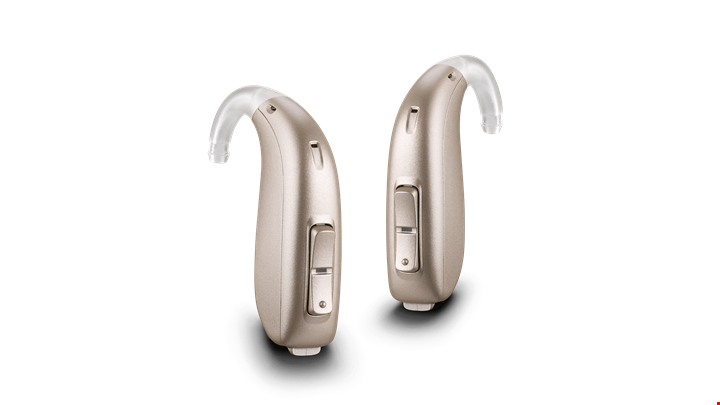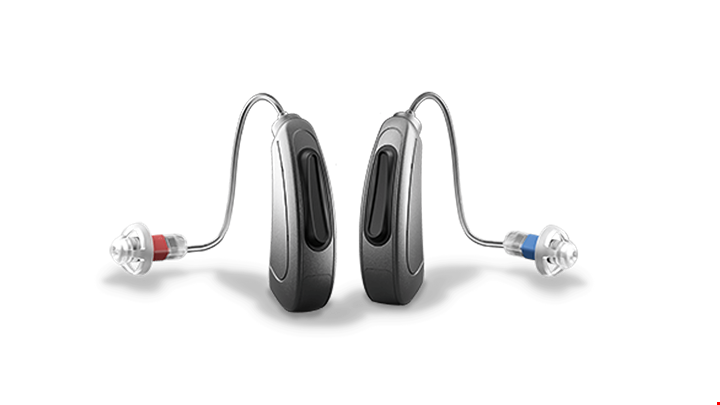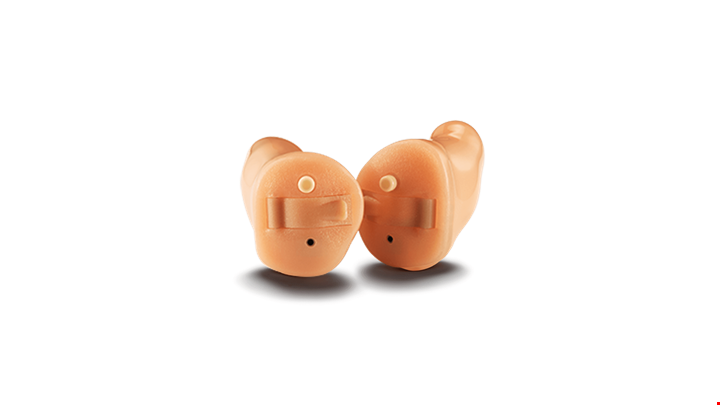

As everyone's hearing is unique, KIND will always offer you the best possible solution for your hearing needs - high-quality behind- and in-the-ear hearing aids. All hearing aids today use digital technology. They are programmable during the fitting process and have multiple listening profiles or memory settings.
Hearing aids models
Your advantages with KIND
KIND basic
KIND basic
KIND comfort
KIND comfort
With all the features of a basic model plus adaptive or automatic features make our KINDcomfort range suitable for people with an active lifestyle. Features like active noise reduction to enhance speech in noisy environments or directional-microphone technology comes standard with these devices. Choose from a variety of models and colours, remote controls, and innovative accessories in a remarkable design.
- Superior sound quality even in noisy environment
- Adaptive Feedback Management
- Adaptive Noise Reduction
- Biosynchronisation & Easy Click
- Rechargeable Batteries
- Accessories like remote control, Phone & TV transmitters
KIND premium
KIND premium
KINDpremium range offers state-of-the-art hearing technology for people with high demands on their hearing aids. These latest digital smart hearing aids scan the environment 100x per second, precise enough to analyse and differentiate between speech and noise so you do not have to concentrate too hard to hear speech even in noisy situations again. What’s more, the powerful 2.4GHz allows direct audio streaming and ensure easy connectivity to enjoy your favourite YouTube videos on iPad®️ or receive telephone calls on iPhone®️ . Imagine a hassle-free and hands-free experience, in stereo, direct to your hearing aids. All hearing aids from our KINDpremium collection are so small and unobtrusive, your family and friends won’t even notice you’re wearing them!
- Excellent sound quality even in noisy environment
- Aggressive Feedback Management to minimise whistling
- Aggressive Noise Reduction so that speech is clearer even in noisy environment
- Biosynchronisation & Easy Click
- Rechargeable Batteries
- Direct audio streaming to iPhone means never miss a phone call again
- Bluetooth connectivity to all smartphones + download Mobile App to use it as a remote control & to set memory programs
- Biosensors to track hearing and health activities which works better than any fitness tracker
- GPS locator to "Find My Hearing Aid"
- Fall Detection Alerts - sends SMS to caregivers
And many more!
Everything you need to know about hearing aids
Even in ancient times, the first ear trumpets and ear funnels were used to compensate for a diminished sense of hearing. Over the centuries, these acoustic aids were further developed - but this technology soon reached its limits. With the invention of the telephone, hearing aid acoustics also made significant progress. In 1878, Werner von Siemens developed the first telephone for the hard of hearing. In 1901, U.S. engineer Miller R. Hutchinson patented the first portable hearing aid: The "Acousticon" weighed 12 kilograms. This was followed in the 20th century by tabletop and pocket devices and hearing glasses, in which hearing aids were integrated into the temples. The first in-the-ear hearing aid was presented in 1966, the first digital model in 1996.
This is how hearing aids work
Hearing aids consist of a microphone, sound processor and loudspeaker. The microphone picks up the sound, the sound processor adjusts the signals according to the wearer's needs after individual programming, and the loudspeaker plays them back.
Modern hearing aids only work digitally. The central element is the sound processor's microchip, which processes the received sounds. Depending on the type of hearing loss, the chip is programmed to amplify the sounds and frequencies that the wearer of the hearing aid can no longer hear optimally. The programming is done individually according to the hearing profile and can today take into account a number of additional aspects. For example, noise such as traffic noise can be identified and filtered out, the volume can be automatically adjusted and speech can be detected and amplified in a targeted manner. Further possibilities are offered by wireless interfaces, which can be used to connect a hearing aid to a mobile phone, radio or television. Another practical feature is the operation of the hearing aid via smartphone app.
Hearing aids are powered by tiny but powerful batteries.
These types of hearing aids are available
The choice of the appropriate hearing solution depends on the necessary range of functions and personal preferences. A basic distinction is made between behind-the-ear and in-the-ear hearing aids:
- In behind-the-ear hearing aids, the housing containing the components is worn behind the pinna. The amplified sound reaches the ear canal through a small tube and a custom-made ear mould.
This classic design accounts for about 55 to 65 percent of the hearing aids sold in Germany. - Models with an external receiver are a further development of the behind-the-ear design. The behind-the-ear housing contains the microphone and sound processor together with the microchip, while the loudspeaker in the ear mould is positioned directly in the ear canal. The connection is made via a thin cable. These cables are much more inconspicuous than the tubes of the classic behind-the-ear models. The loudspeaker in the earmold also produces a better sound.
Models of this design account for about 25 to 35 percent of the hearing aids sold in Germany. - With an in-the-ear hearing aid, all components are housed in a custom-made housing that is worn directly in the ear canal. These models are almost invisible.
Since these devices are not suitable for every ear, the proportion of hearing aids of this type sold is around five to ten percent.
Technological innovations with hearing aids
The rapid progress made by digitalisation has a great influence on the further development of hearing aids:
- Wireless interfaces and smartphone apps
There is a growing demand for the function of connecting hearing aids to other devices by radio. The advantages are obvious: A telephone call can be made without holding a mobile phone or a telephone receiver to the ear. The voice of the conversation partner is processed directly in the hearing aids, unaffected by background noise and the possibly poor loudspeaker quality of the telephone. The hearing aids automatically adjust to the hearing situation "phone call". Music and other audio sources such as audio books and television are transmitted in stereo quality directly to the hearing aids - again unaffected by background noise.Today, hearing aids can also be adjusted via app with the smartphone. Using geotagging, the smartphone remembers stored locations, such as a concert hall, and automatically forwards the desired settings to the hearing aids.
- Coordination between hearing aids of both ears
Wireless connections also allow for better matching of two hearing aids. The devices can exchange control information in real time and thus optimally adapt to the respective hearing situation. For this purpose, the acoustic information of both hearing aids is evaluated. In this way, they simulate the natural interaction of the ears. - Ever smaller and more discreet design
As the components shrink, hearing aids become more and more discreet. High-quality materials make them more attractive, nanotechnologies less sensitive to environmental influences and therefore more hygienic.
The production of the earmoulds is computer-aided. The ear impressions are stored as data files that serve as templates for 3D printers. The archiving of the files guarantees a fast new production in case of loss or damage. - Upgradeable hearing aids
The microchips of modern hearing aids work with special software. This software can be upgraded to include additional functions, such as comfort functions that did not appear necessary at the time of purchase.
Buy hearing aids: Advice and service are especially important
Buying hearing aids - this is only one step on the way to an optimal hearing solution. For KIND, good advice and comprehensive service are at the centre of this journey. That's why we offer a holistic approach to hearing aid fitting that comprises several components:
- In a competent consultation we find the optimal hearing aid fitting for our customers. The highest level of transparency is particularly important: The customer is informed about the process of hearing aid fitting and the ENT physician is involved in the prescription and control process. Product recommendations are always tailored to the needs of the customer and are based on the individual requirements of the customer.
Are you interessted in KIND hearing aids?
-
In addition to our initial consultation, the comprehensive KIND service package includes hearing aid fitting and KIND service. Hearing aid fitting includes individual customisation and free, non-binding trial fitting in familiar surroundings. Further points are programming, optimisation of wearing comfort and instruction in the use and care of the hearing aids. Finally, the fine-tuning and the success control take place.
|
|
Shanon Yap "KIND Hearing provided an extremely caring and quality service both at my mother's initial hearing aid demonstration and after my purchase. I have no hesitation in awarding 5 stars and would recommend them for everyone looking for a solution for hearing loss." |
|||






